Effects of Dynamic Changes of Soil Moisture and Salinity on Plant Community in the Bosten Lake Basin
Abstract
1. Introduction
2. Materials and Methods
2.1. Study Area
2.2. Remote Sensing Data
2.3. Investigation of Plant Community Types and Diversity
2.4. Data Processing and Calculation Methods
3. Results
3.1. Dynamic Characteristics of Soil Moisture, Salinity, and Plant Communities in the Bosten Lake Basin
3.2. Relationship between Soil Characteristics and Plant Productivity in the Bosten Lake Basin
3.3. Effects of Soil Characteristics on the Coverage Area of Plant Communities in the Bosten Lake Basin
3.4. Effects of Soil Moisture-Salinity Interaction on the Plant Diversity and Productivity of Plant Communities in the Bosten Lake Basin
4. Discussion
5. Conclusions
Author Contributions
Funding
Institutional Review Board Statement
Informed Consent Statement
Data Availability Statement
Acknowledgments
Conflicts of Interest
References
- Tilman, D.; Downing, J.A. Biodiversity and stability in grasslands. Nature 1994, 367, 363–365. [Google Scholar] [CrossRef]
- Fraser, L.H.; Karnezis, J.P. A comparative assessment of seedling survival and biomass accumulation for fourteen wetland plant species grown under minor water-depth differences. Wetlands 2005, 25, 520–530. [Google Scholar] [CrossRef]
- Zhang, Z.; Wan, C.; Zheng, Z.; Hu, L.; Feng, K.; Chang, J.; Xie, P. Plant community characteristics and their responses to environmental factors in the water level fluctuation zone of the three gorges reservoir in China. Env. Sci. Pollut. Res. Int. 2013, 20, 7080–7091. [Google Scholar] [CrossRef] [PubMed]
- Xu, P.J.; Xu, L.P.; Wang, H. Changes of NDVI and its response to climate change in Boston Lake Basin. J. Water Resour. Water Eng. 2018, 29, 86–92. [Google Scholar]
- Feng, Q.; Zhao, W.W.; Qiu, Y. Spatial heterogeneity of soil moisture and the scale variability of its influencing factors: A case study in the Loess Plateau of China. Water 2013, 5, 1226–1242. [Google Scholar] [CrossRef]
- Devoto, M.; Medan, D.; Roig-Alsina, A.; Montaldo, N.H. Patterns of species turnover in plant-pollinator communities along a precipitation gradient in Patagonia (Argentina). Austral Ecol. 2009, 34, 848–857. [Google Scholar] [CrossRef]
- Maharjan, S.K.; Poorter, L.; Holmgren, M.; Bongers, F.; Wieringa, J.J.; Hawthorne, W.D. Plant functional traits and the distribution of west African rain forest trees along the rainfall gradient. Biotropica 2011, 43, 552–561. [Google Scholar] [CrossRef]
- Zenner, E.K.; Olszewski, S.L.; Palik, B.J.; Kastendick, D.N.; Peck, J.E.; Blinn, C.R. Riparian vegetation response to gradients in residual basal area with harvesting treatment and distance to stream. For. Ecol. Manag. 2012, 283, 66–76. [Google Scholar] [CrossRef]
- Chen, Y.N.; Zilliacus, H.; Li, W.H.; Zhang, H.F.; Chen, Y.P. Ground-water level affects plant species diversity along the lower reaches of the Tarim River, Western China. J. Arid Environ. 2006, 66, 231–246. [Google Scholar] [CrossRef]
- Xi, H.Y.; Feng, Q.; Zhang, L. Effects of water and salinity on plant species composition and community succession in Ejina D esert Oasis, northwest China. Env. Earth Sci. 2016, 75, 138. [Google Scholar] [CrossRef]
- McIlroy, S.K.; Allen-Diaz, B.H. Plant community distribution along water table and grazing gradients in montane meadows of the Sierra Nevada Range (California, USA). Wetl. Ecol. Manag. 2012, 20, 287–296. [Google Scholar] [CrossRef]
- Li, Z.K.; Li, X.Y.; Zhou, S.; Yang, X.F.; Fu, Y.S.; Miao, C.Y.; Wang, S.; Zhang, G.H.; Wu, X.C.; Yang, C.; et al. A comprehensive review on coupled processes and mechanisms of soil-vegetation-hydrology, and recent research advances. Sci. China Earth Sci. 2022, 65, 1–31. [Google Scholar] [CrossRef]
- Davis, J.A.; McGuire, M.; Halse, S.A. What happens when you add salt: Predicting impacts of secondary salinisation on shallow aquatic ecosystems by using an alternative-states model. Aust. J. Bot. 2003, 51, 715–724. [Google Scholar] [CrossRef]
- González-Alcaraz, M.N.; Jiménez-Cárceles, F.J.; Álvarez, Y.; Álvarez-Rogel, J. Gradients of soil salinity and moisture, and plant distribution, in a Mediterranean semiarid saline watershed: A model of soil–plant relationships for contributing to the management. Catena 2014, 115, 150–158. [Google Scholar] [CrossRef]
- Cardinale, B.J. Biodiversity improves water quality through niche partitioning. Nature 2011, 472, 86–89. [Google Scholar] [CrossRef] [PubMed]
- Berdugo, M.; Delgadobaquerizo, M.; Soliveres, S. Global ecosystem thresholds driven by aridity. Science 2020, 367, 787–790. [Google Scholar] [CrossRef]
- Onkware, A.O. Effect of soil salinity on plant distribution and production at Loburu Delta, Lake Bogoria National Reserve, Kenya. Austral. Ecol. 2000, 25, 140–149. [Google Scholar] [CrossRef]
- Wetzel, P.R.; Kitchens, W.M.; Brush, J.M.; Dusek, M.L. Use of a reciprocal transplant study to measure the rate of plant community change in a tidal marsh along a salinity gradient. Wetlands 2004, 24, 879–890. [Google Scholar] [CrossRef]
- Wang, S.X.; Dong, X.G.; Liu, L. Diversity and Differentiation of Natural Vegetation Under Water and Salt Gradient in Oasis of Yanqi Basin, Xinjiang. J. Glaciol. Geocryol. 2010, 32, 999–1006. [Google Scholar]
- Cui, B.S.; Zhao, X.S.; Yang, Z.F.; Chen, B.; Tang, N.; Tan, X. Responses of reed community to the environment gradient of water depth in the Yellow River Delta. Acta Ecol. Sin. 2006, 26, 1534–1541. [Google Scholar] [CrossRef]
- Wang, G.X.; Xia, J.; Li, X.Y. Critical advances in understanding ecohydrological processes of terrestrial vegetation: From leaf to watershed scale. Chin. Sci. Bull 2021, 66, 3667–3683. [Google Scholar] [CrossRef]
- Dong, X.G.; Jiang, H.F.; Deng, M.J. Study on the distribution and balance of the salt in the inland basin. Adv. Water Sci. 2005, 16, 638–642. [Google Scholar]
- Dai, X.; Yang, X.; Wang, M.; Gao, Y.; Liu, S.; Zhang, J. The dynamic change of Bosten Lake area in response to climate in the past 30 years. Water 2020, 12, 4. [Google Scholar] [CrossRef]
- Dilxiati, M.; Rusul, Y.; Hong, J. Temporal and spatial variation of vegetation phenology and its driving factor analysis in the Bosten Lake Drainage Basin from 2001 to 2014. Acta Ecol. Sin. 2018, 38, 6921–6931. [Google Scholar]
- Wei, B. Study on morphological changes and influencing factors of Bosten Lake. Ph.D. Thesis, Xinjiang University, Ürümqi, China, 2013. [Google Scholar]
- Roy, D.P.; Kovalskyy, V.; Zhang, H.K. Characterization of Landsat-7 to Landsat-8 reflective wavelength and normalized difference vegetation index continuity. Remote Sens. Environ. 2016, 185, 57–70. [Google Scholar] [CrossRef]
- Gitelson, A.A.; Kaufman, Y.J.; Merzlyak, M.N. Use of a green channel in remote sensing of global vegetation from EOS-MODIS. Remote Sens. Environ. 1996, 58, 289–298. [Google Scholar] [CrossRef]
- Nagler, P.L.; Scott, R.L.; Westenburg, C.; Cleverly, J.R.; Glenn, E.P.; Huete, A.R. Evapotranspiration on western U.S. rivers estimated using the Enhanced Vegetation Index from MODIS and data from eddy covariance and Bowen ratio flux towers. Remote Sens. Environ. 2005, 97, 337–351. [Google Scholar] [CrossRef]
- Jordan, C.F. Derivation of leaf—Area index from quality of light on the forest floor. Ecology 1969, 50, 663–666. [Google Scholar] [CrossRef]
- Zeng, J.Y.; Chen, K.S.; Cui, C.Y.; Bai, X.J. A Physically-based Soil Moisture Index from Passive Microwave Brightness Temperatures for Soil Moisture Variation Monitoring. IEEE Trans. Geosci. Remote Sens. 2020, 58, 2782–2795. [Google Scholar] [CrossRef]
- Khan, N.M.; Rastoskuev, V.V.; Sato, Y.; Shiozawa, S. Assessment of hydro saline land degradation by using a simple approach of remote sensing indicators. Agric. Water Manag. 2005, 77, 96–109. [Google Scholar] [CrossRef]
- Ahmad, S.; Kalra, A.; Stephen, H. Estimating soil moisture using remote sensing data: A machine learning approach. Adv. Water Resour. 2010, 33, 69–80. [Google Scholar] [CrossRef]
- Holtgrave, A.K.; Förster, M.; Greifeneder, F. Estimation of Soil Moisture in Vegetation-Covered Floodplains with Sentinel-1 SAR Data Using Support Vector Regression. PFG 2018, 86, 85–101. [Google Scholar] [CrossRef]
- Ma, K.P. Methods for Measuring Biodiversity of Biological Communities Iα. Divers. Meas. 1994, 3, 162–168. [Google Scholar]
- Pei, Z.F.; Fang, S.B.; Yang, W.N.; Wang, L.; Wu, M.Y.; Zhang, Q.F.; Han, W.; Khoi, D.N. The Relationship between NDVI and Climate Factors at Different Monthly Time Scales: A Case Study of Grasslands in Inner Mongolia, China (1982–2015). Sustainability 2019, 11, 7243. [Google Scholar] [CrossRef]
- Decuyper, M.; Chávez, R.O.; Čufar, K.; Estay, S.A.; Clevers, J.G.P.W.; Prislan, P.; Gričar, J.; Črepinšek, Z.; Merela, M.; de Luis, M.; et al. Spatio-temporal assessment of beech growth in relation to climate extremes in Slovenia–An integrated approach using remote sensing and tree-ring data. Agric. For. Meteorol. 2020, 287, 107925. [Google Scholar] [CrossRef]
- Wan, H.X.; Qin, Z.H.; Xu, Y.M. Variation of vegetation cover and its relationship with climatic factors in the Bosten Lake Basin using MODIS data. J. Lake Sci. 2018, 30, 1429–1437. [Google Scholar]
- Kang, E.; Li, X.; Zhang, J.; Xing, L.H. Water resources relating to desertification in the Hexi area of Gansu Province, China. J. Glaciol. Geocryol. 2004, 26, 657–667. [Google Scholar]
- Kempping, J.; Niittynen, P.; Happonen, K. Consistent trait-environment relationships within and across tundra plant communities. Nat. Ecol. Evol. 2021, 5, 458–467. [Google Scholar] [CrossRef]
- Shen, X.J.; Deng, M.J.; Lu, X.G. Aboveground biomass and its spatial distribution pattern of herbaceous marsh vegetation in China. Sci. China Earth Sci. 2021, 64, 1115–1125. [Google Scholar] [CrossRef]
- Zhou, W.L.; Yang, X.Q.; Hao, P.; Liu, Q.W.; Cao, D.C.; Baribault, T.; Li, J.W. Plant diversity and its maintenance in Populus euphratica riparian forests in the Ejina Oasis, China. For. Stud. China 2010, 12, 55–61. [Google Scholar] [CrossRef]
- Zhang, J.; Lyu, G.H.; Wang, H.F. Effect of plant diversity on ecosystem multifunctionality in different water-salt environments of Ebinur Lake basin. J. Plant Resour. Environ. 2021, 30, 22–30. [Google Scholar]
- Shen, X.J.; Liu, Y.W.; Liu, B.H. Effect of shrub encroachment on land surface temperature in semi-arid areas of temperate regions of the Northern Hemisphere. Agric. For. Meteorol. 2022, 320, 108943. [Google Scholar] [CrossRef]
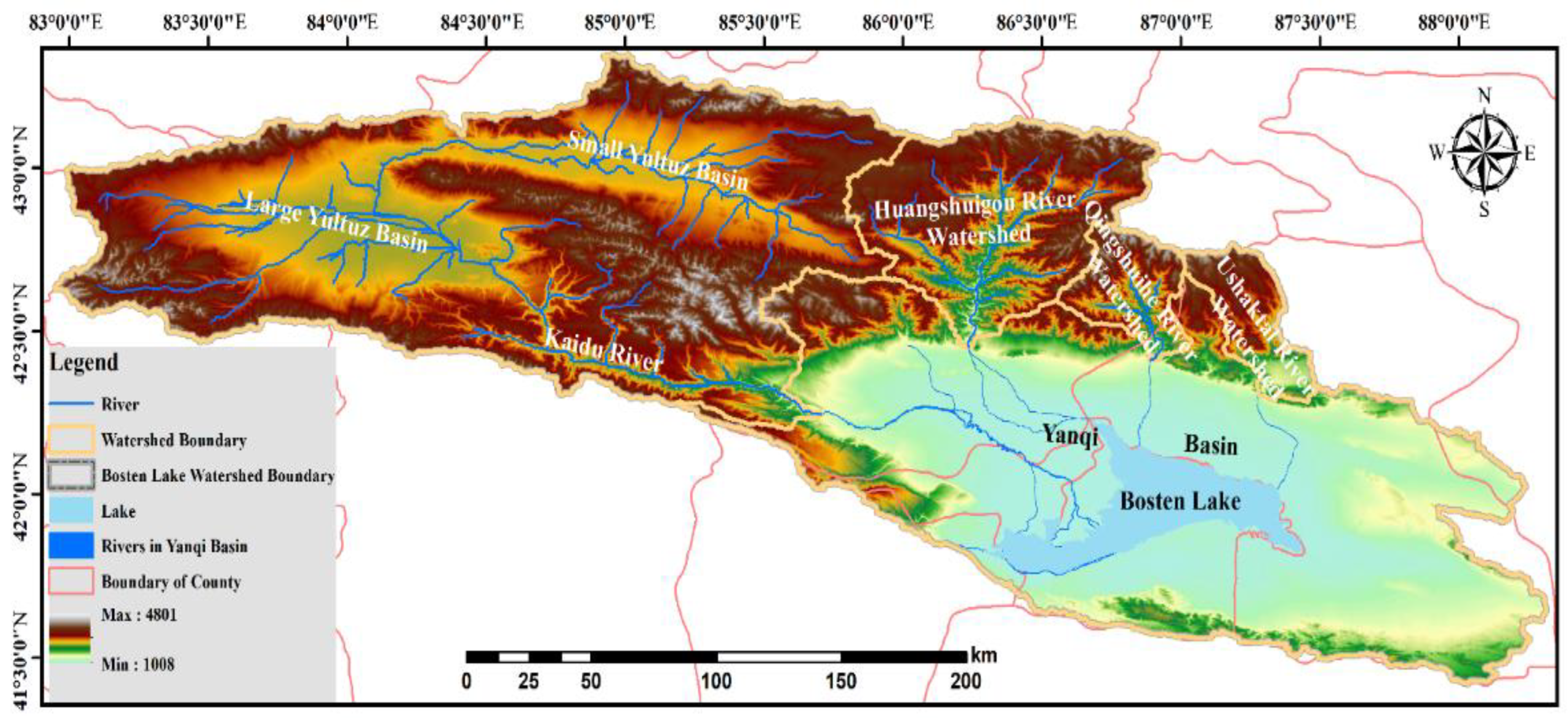
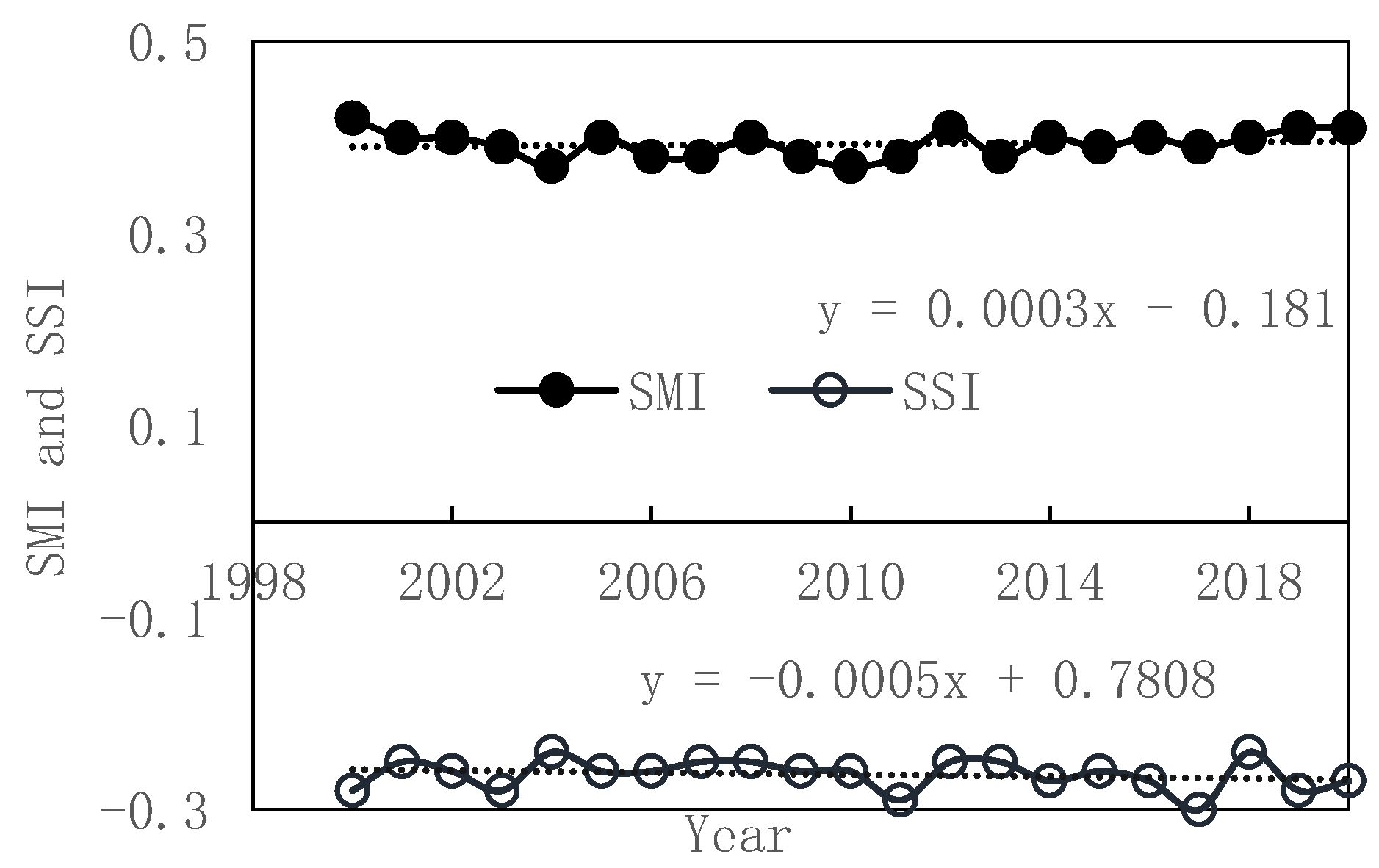

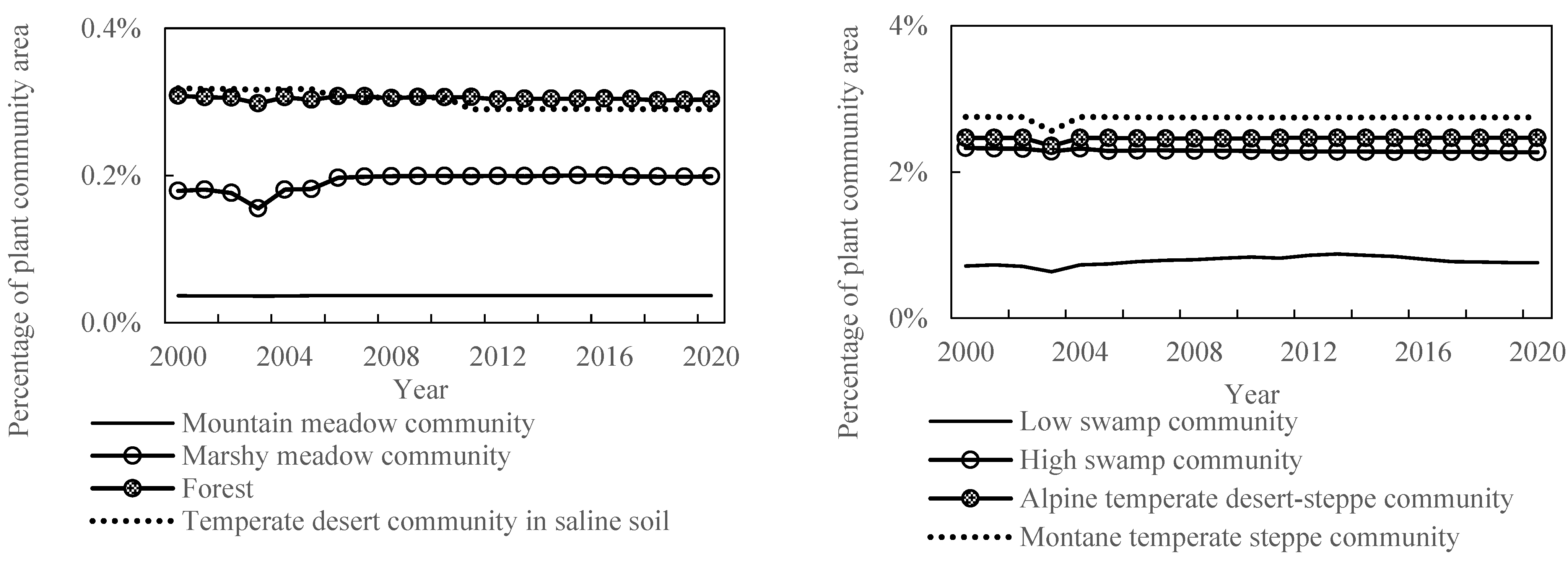
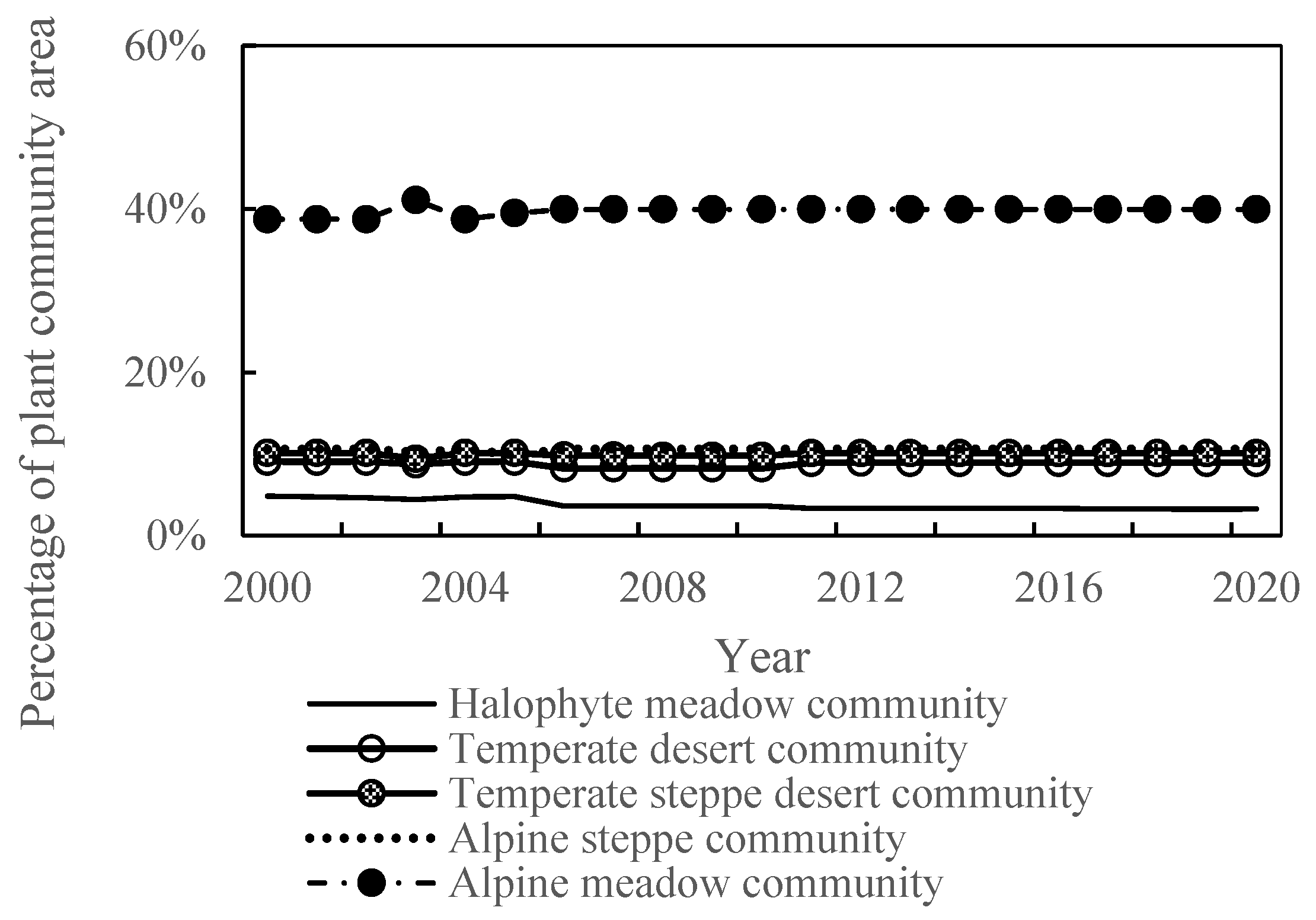
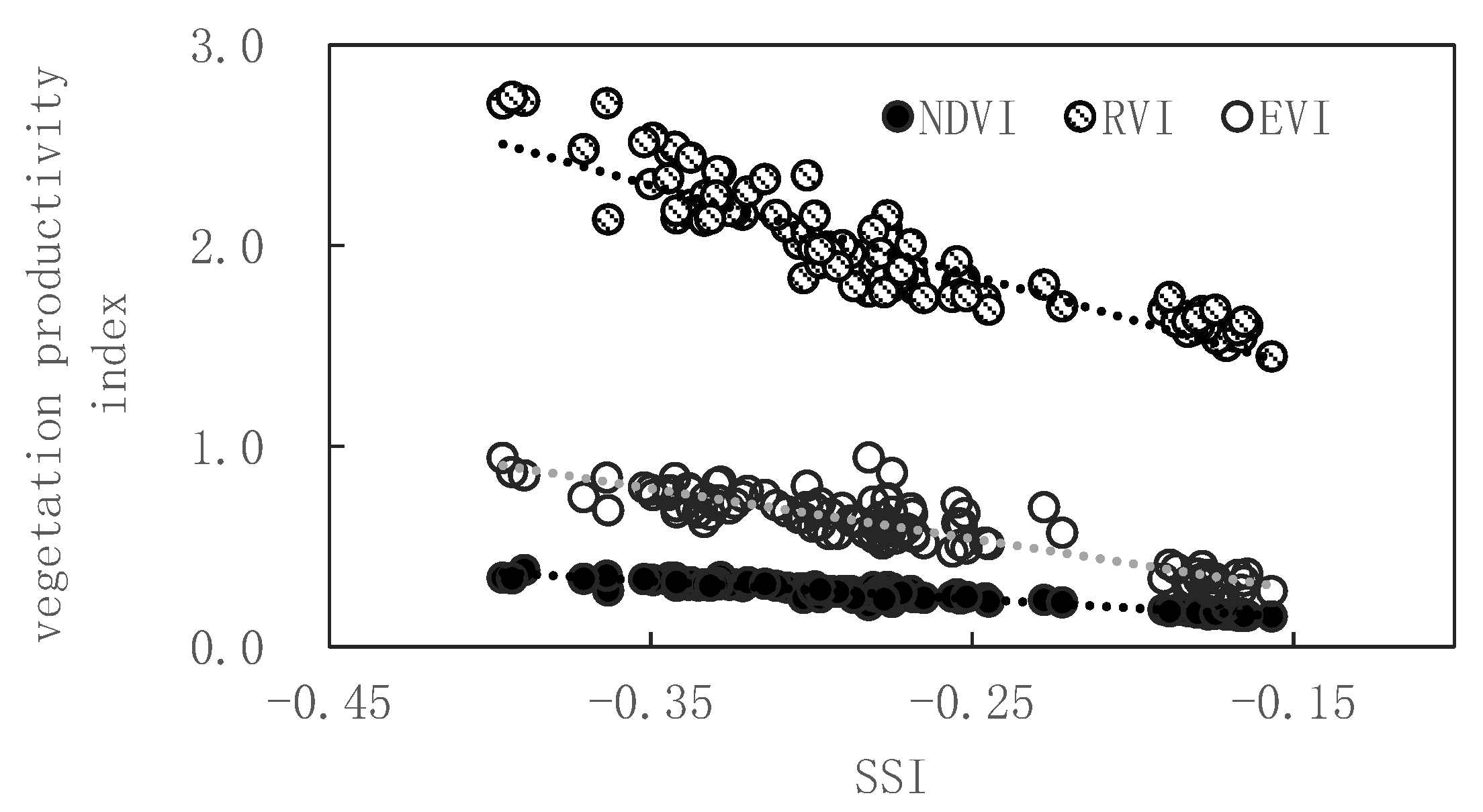
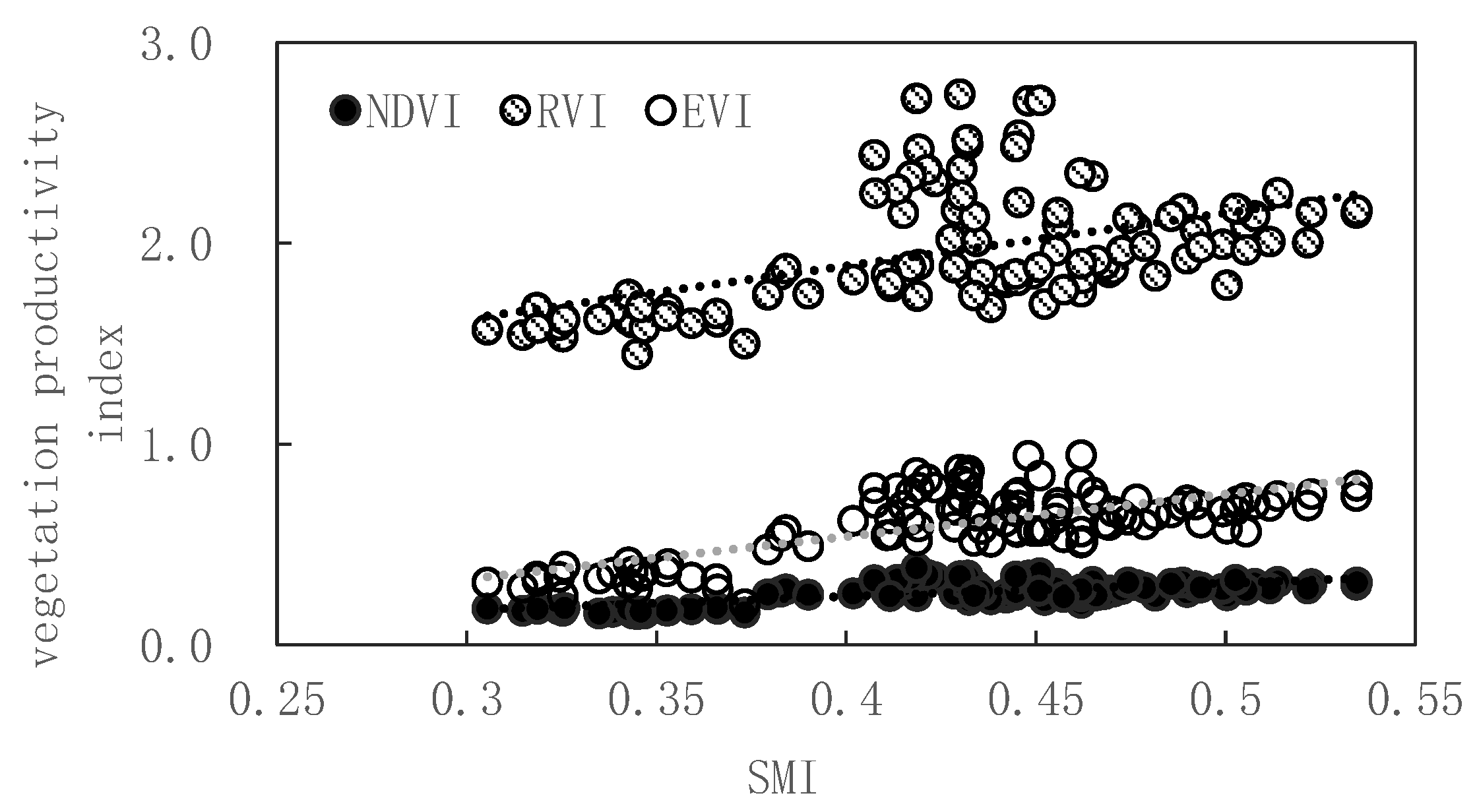
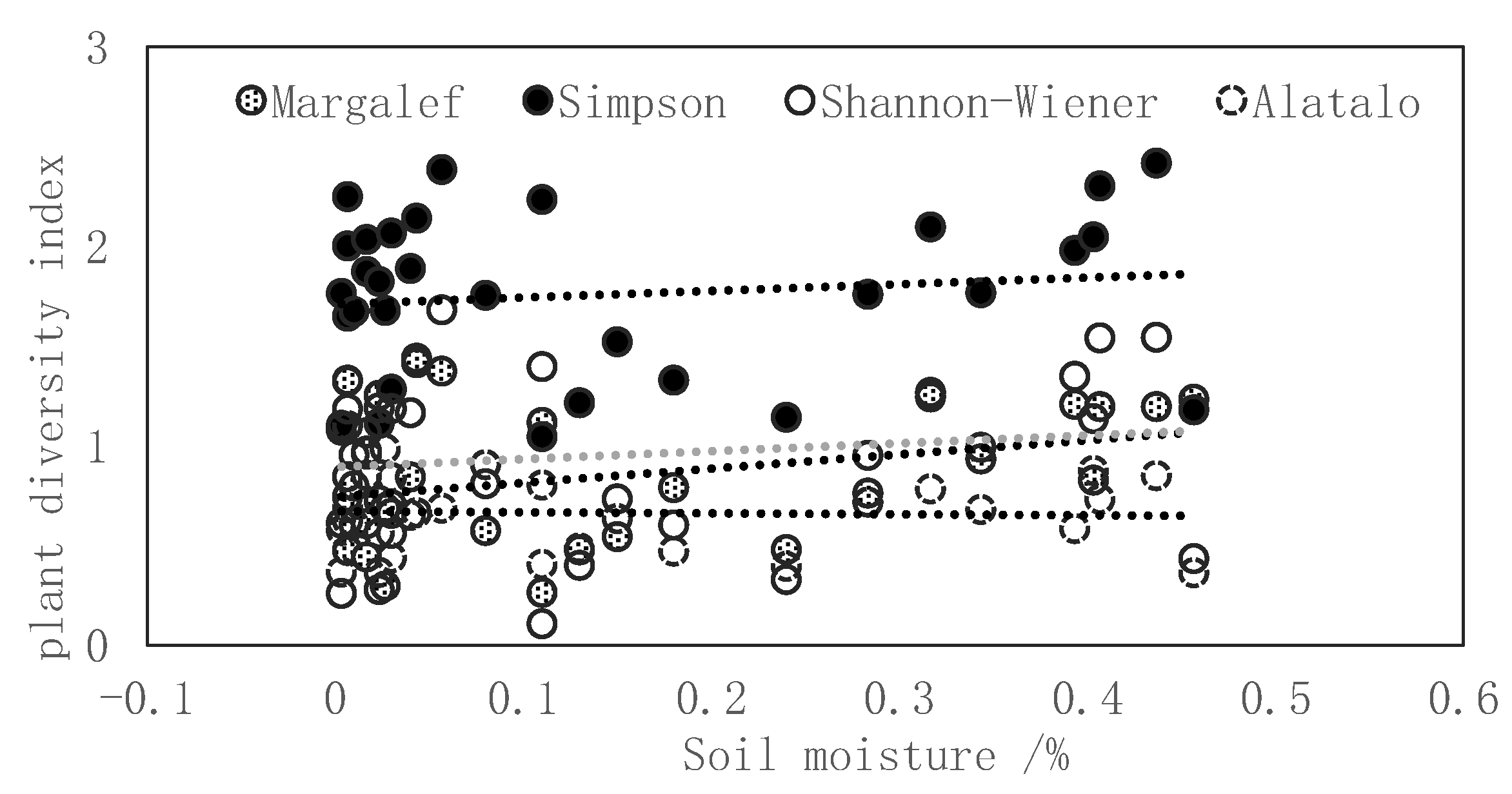


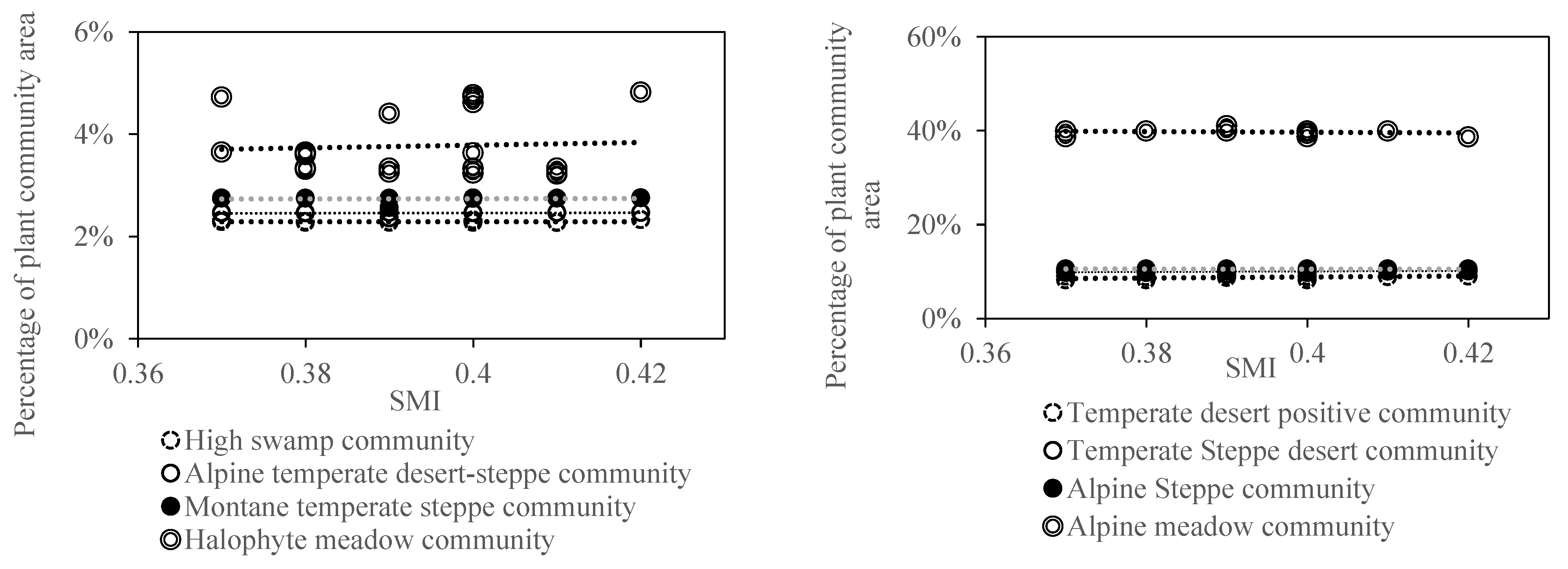
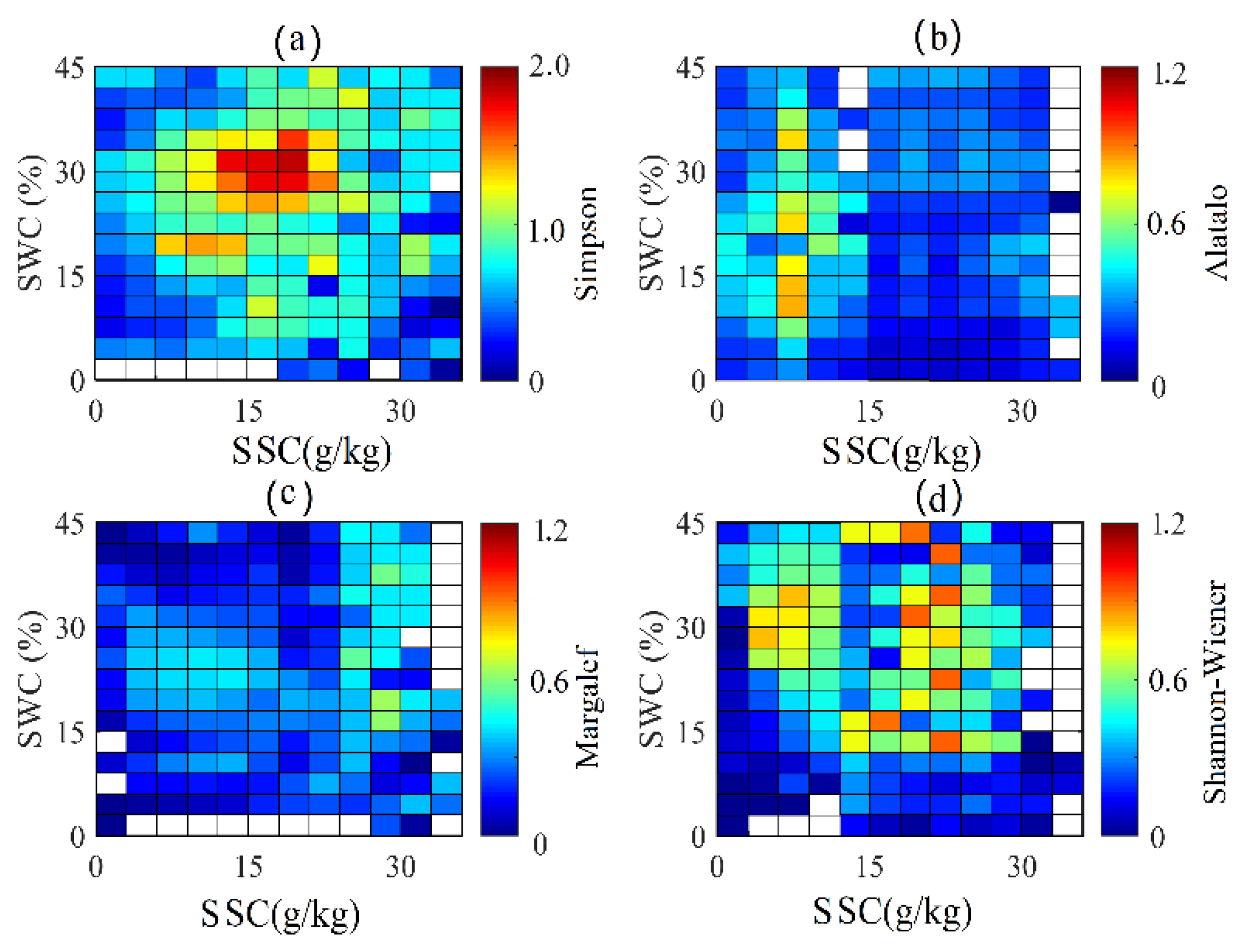
| Number | Plant Communities/Land Cover |
|---|---|
| 1 | Halophyte meadow community |
| 2 | Marshy meadow community |
| 3 | Low swamp community |
| 4 | Alpine steppe community |
| 5 | Alpine meadow community |
| 6 | High swamp community |
| 7 | Sub-class of sandy temperate desert community |
| 8 | Temperate steppe desert community |
| 9 | Temperate desert community |
| 10 | Gravelly temperate steppe desert sub-class community |
| 11 | Mountain meadow community |
| 12 | Montane temperate steppe community |
| 13 | Alpine temperate desert-steppe community |
| 14 | Temperate desert community in saline soil |
| 15 | Cultivated land |
| 16 | Water area |
| 17 | Forest |
| 18 | Glaciers and snow |
| 19 | Construction Land |
| Index Name | Formula * | Reference |
|---|---|---|
| NDVI | [27] | |
| EVI | [28] | |
| RVI | [29] | |
| SSI | [30] | |
| SMI | [31] |
| Linear Regression Model | Equation Test Significance | |||
|---|---|---|---|---|
| R2 | F | Sig. | ||
| 1 | YNDVI = −0.879 X1 + 0.026 X2 + 0.007 | 0.918 | 572.734 | 0.000 |
| 2 | YRVI = −5.190 X1 − 1.139 X2 + 1.026 | 0.838 | 264.243 | 0.000 |
| 3 | YEVI = −2.160 X1 + 0.545 X2 − 0.227 | 0.810 | 217.453 | 0.000 |
Publisher’s Note: MDPI stays neutral with regard to jurisdictional claims in published maps and institutional affiliations. |
© 2022 by the authors. Licensee MDPI, Basel, Switzerland. This article is an open access article distributed under the terms and conditions of the Creative Commons Attribution (CC BY) license (https://creativecommons.org/licenses/by/4.0/).
Share and Cite
Hou, J.; Ye, M. Effects of Dynamic Changes of Soil Moisture and Salinity on Plant Community in the Bosten Lake Basin. Sustainability 2022, 14, 14081. https://doi.org/10.3390/su142114081
Hou J, Ye M. Effects of Dynamic Changes of Soil Moisture and Salinity on Plant Community in the Bosten Lake Basin. Sustainability. 2022; 14(21):14081. https://doi.org/10.3390/su142114081
Chicago/Turabian StyleHou, Jiawen, and Mao Ye. 2022. "Effects of Dynamic Changes of Soil Moisture and Salinity on Plant Community in the Bosten Lake Basin" Sustainability 14, no. 21: 14081. https://doi.org/10.3390/su142114081
APA StyleHou, J., & Ye, M. (2022). Effects of Dynamic Changes of Soil Moisture and Salinity on Plant Community in the Bosten Lake Basin. Sustainability, 14(21), 14081. https://doi.org/10.3390/su142114081





